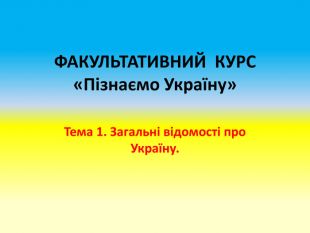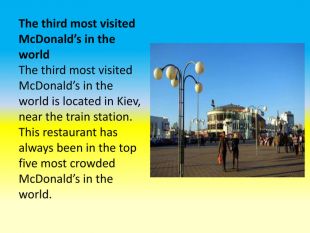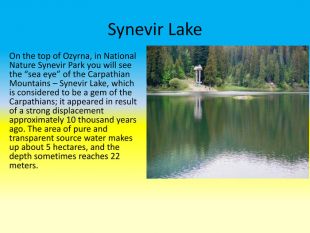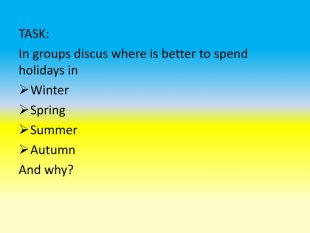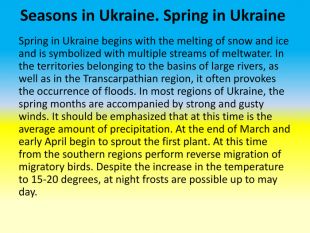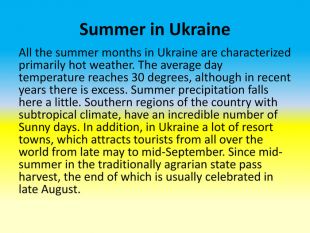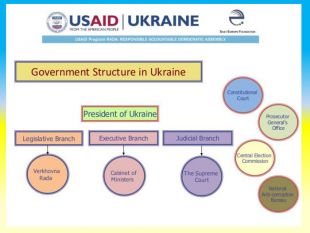Мультимедійний супровід до факультативного курсу "Пізнаємо Україну" 9 клас
КАЛЕНДАРНО-ТЕМАТИЧНЕ ПЛАНУВАННЯ ФАКУЛЬТАТИВНОГО КУРСУ
«Пізнаємо Україну»
9 КЛАС
35 год на рік
(І семестр – 16 годин, 1 година на тиждень, ІІ семестр - 19 годин,
1 година на тиждень.)
І семестр
|
№ п/п |
Дата |
Тема заняття
|
К – ть год. |
Корегув. |
|
1. |
|
Тема 1. Загальні відомості про Україну. Карта України.. Країни – сусіди України. Співробітництво з сусідніми державами. |
1 год. |
|
|
2. |
|
Гори України. Водні ресурси країни. Адміністративний розподіл України. |
1 год. |
|
|
3. |
|
Кліматичні умови країни |
1 год. |
|
|
4. |
|
Пори року в Україні. Популярні місця для відпочинку туристів. |
1 год. |
|
|
5. |
|
Державний устрій України. Державний прапор України. |
1 год. |
|
|
6. |
|
Історія виникнення державного гербу. Національний гімн України. |
1 год. |
|
|
7. |
|
Традиції українського народу. Звичаї. |
1 год. |
|
|
8. |
|
Український характер. Стиль життя українців. Стереотипи щодо українців. Мешканці села та міста. |
1 год. |
|
|
9. |
|
Проектна робота. Тематичне оцінювання. |
1 год. |
|
|
10. |
|
Тема 2. Літературна спадщина України. Джерела інформації. |
1 год. |
|
|
11. |
|
Бібліотеки країни. Національна бібліотека ім. В. Вернадського. |
1 год. |
|
|
12. |
|
Т. Шевченко – духовний скарб України. Біографія Т. Шевченка. |
1 год. |
|
|
13. |
|
Художня спадщина Т. Шевченка. |
1 год. |
|
|
14. |
|
Роль Т. Шевченка в українській історії. |
1 год. |
|
|
15. |
|
Визначні поетичні твори Т.Г. Шевченка. |
1 год. |
|
|
16. |
|
Проектна робота. |
1 год. |
|
ІІ семестр
|
№ п/п |
Дата |
Тема заняття
|
К – ть год. |
Примітка |
|
17. |
|
Тема 3. Освіта в Україні. Структура освіти в Україні. |
1 год. |
|
|
18. |
|
Типи навчальних закладів в Україні. |
1 год. |
|
|
19. |
|
Мовні школи в Україні. |
1 год. |
|
|
20. |
|
Державні стандарти освіти. |
1 год. |
|
|
21. |
|
Система незалежного тестування в Україні. |
1 год. |
|
|
22. |
|
Вища освіта в Україні. |
1 год. |
|
|
23. |
|
Проектна робота «Школа моєї мрії». Тематичне оцінювання. |
1 год. |
|
|
24. |
|
Тема 4. Культурне життя в Україні. Українські національні музичні інструменти. |
1 год. |
|
|
25. |
|
Історія національної музики. |
1 год. |
|
|
26. |
|
Історія національного танцю. |
1 год. |
|
|
27. |
|
Душа української пісні. |
1 год. |
|
|
28. |
|
Життя та діяльність М. Лисенка. |
1 год. |
|
|
29. |
|
Засоби масової інформації в Україні. |
1 год. |
|
|
30. |
|
Газети України. |
1 год. |
|
|
31. |
|
Журнали України. Журнали для молоді. |
1 год. |
|
|
32. |
|
Робота українських журналістів. Моє відношення до сучасної преси та новин. |
1 год. |
|
|
33-34 |
|
Робота над темами, визначеними вчителем. |
2 год. |
|
|
35. |
|
Проектна робота. |
1 год. |
|
-
У презентаціях є грубі граматичні помилки, які вчителю не можна допускати.


про публікацію авторської розробки
Додати розробку








![Taras Hryhorovich Shevchenko. Taras Hryhorovich Shevchenko (b. Feb. 25 [March 9, New Style], 1814, Morintsy, Ukraine, –d. Feb. 26 [March 10], 1861, St. Petersburg, Russia), is the foremost Ukrainian poet, prose writer, painter and playwright of the 19th century. He was a major figure of the Ukrainian national revival. Taras Shevchenko was a man of universal talent. All his life and creative work were dedicated to the people of Ukraine. The poet dreamed about the times when his country would be a free sovereign state, where the Ukrainian language, clture and history would be highly valued, and the people would be happy and free. Taras Hryhorovich Shevchenko. Taras Hryhorovich Shevchenko (b. Feb. 25 [March 9, New Style], 1814, Morintsy, Ukraine, –d. Feb. 26 [March 10], 1861, St. Petersburg, Russia), is the foremost Ukrainian poet, prose writer, painter and playwright of the 19th century. He was a major figure of the Ukrainian national revival. Taras Shevchenko was a man of universal talent. All his life and creative work were dedicated to the people of Ukraine. The poet dreamed about the times when his country would be a free sovereign state, where the Ukrainian language, clture and history would be highly valued, and the people would be happy and free.](/uploads/files/51049/113730/121389_images/8.jpg)














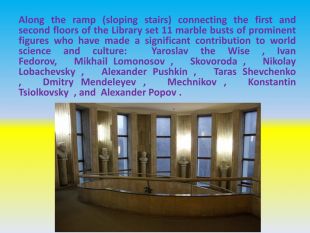






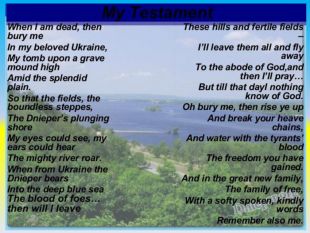










































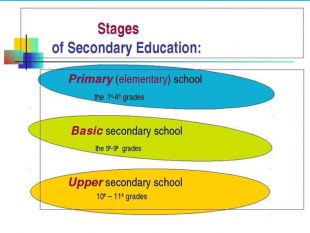













































![Mykola Vitaliyovych Lysenko22 March [10 March] 1842 – 6 November [24 October] 1912 He was a Ukrainian composer, pianist, conductor and ethnomusicologist. Mykola Vitaliyovych Lysenko22 March [10 March] 1842 – 6 November [24 October] 1912 He was a Ukrainian composer, pianist, conductor and ethnomusicologist.](/uploads/files/51049/113730/121391_images/15.jpg)
![Lysenko was born in Hrynky, Kremenchuk county, Poltava Governorate,[1] the son of Vitaliy Romanovych Lysenko (Ukrainian: Віталій Романович Лисенко). From childhood he became very interested in the folksongs of Ukrainian peasants and by the poetry of Taras Shevchenko. When Shevchenko's body was brought to Ukraine after his death in 1861, Lysenko was a pallbearer. During his time at Kiev University, Lysenko collected and arranged Ukrainian folksongs, which were published in seven volumes. One of his principal sources was the kobzar Ostap Veresai (after whom Lysenko later named his son). Lysenko was initially a student of Biology at the Kharkiv University, studying music privately. On a scholarship which he won from the Russian Music Society he pursued further professional music studies at the Leipzig Conservatory. It is there that he understood the importance of collecting, developing and creating Ukrainian music rather than duplicating the work of Western classical composers. Lysenko was born in Hrynky, Kremenchuk county, Poltava Governorate,[1] the son of Vitaliy Romanovych Lysenko (Ukrainian: Віталій Романович Лисенко). From childhood he became very interested in the folksongs of Ukrainian peasants and by the poetry of Taras Shevchenko. When Shevchenko's body was brought to Ukraine after his death in 1861, Lysenko was a pallbearer. During his time at Kiev University, Lysenko collected and arranged Ukrainian folksongs, which were published in seven volumes. One of his principal sources was the kobzar Ostap Veresai (after whom Lysenko later named his son). Lysenko was initially a student of Biology at the Kharkiv University, studying music privately. On a scholarship which he won from the Russian Music Society he pursued further professional music studies at the Leipzig Conservatory. It is there that he understood the importance of collecting, developing and creating Ukrainian music rather than duplicating the work of Western classical composers.](/uploads/files/51049/113730/121391_images/16.jpg)







































































![The Cabinet is responsible to the President of Ukraine and is under the control and being held accountable to the Verkhovna Rada (Ukrainian parliament). It consists of the Prime Minister, the First Vice-Prime Minister, three[4] Vice-Prime Ministers, and other Ministers, who head their assigned Ministries (departments). The Cabinet is responsible to the President of Ukraine and is under the control and being held accountable to the Verkhovna Rada (Ukrainian parliament). It consists of the Prime Minister, the First Vice-Prime Minister, three[4] Vice-Prime Ministers, and other Ministers, who head their assigned Ministries (departments).](/uploads/files/51049/113730/121392_images/34.jpg)













